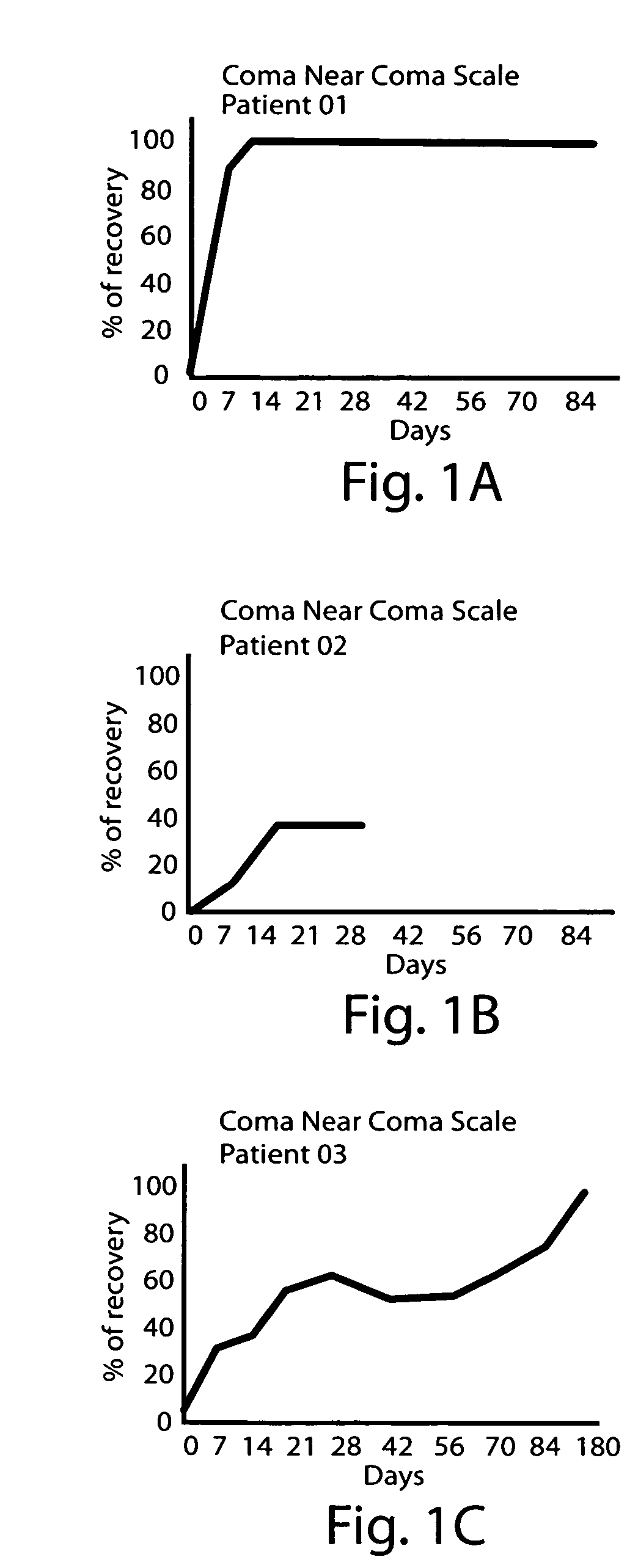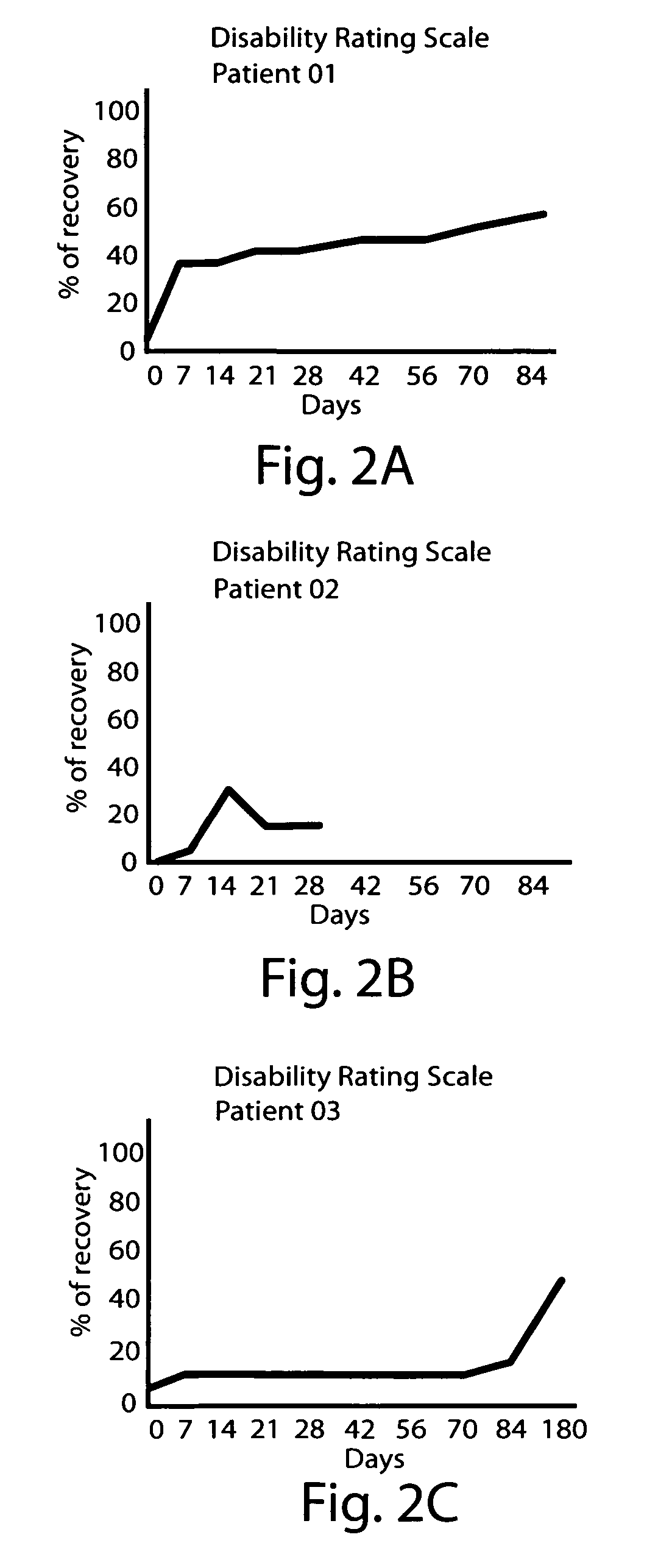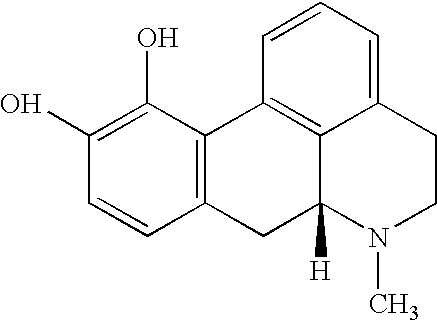High potency dopaminergic treatment of neurological impairment associated with brain injury
a brain injury and high-potency technology, applied in the field of neurorehabilitation, can solve the problems of patients not fully, functionally, fully arising no generally accepted therapeutic options to promote emergence from an altered state of consciousness, so as to achieve high-potency dopaminergic effects, reduce dose, and shorten duration
- Summary
- Abstract
- Description
- Claims
- Application Information
AI Technical Summary
Benefits of technology
Problems solved by technology
Method used
Image
Examples
example 1
Emergence from Altered Consciousness State by Treatment with Elevated Levels of Levodopa (L-Dopa)
[0092]An open-label study was performed to evaluate the response of administering elevated doses of L-dopa (levadopa) to patients in a persistent vegetative state (PVS) or a minimally conscious state (MCS) following traumatic brain injury.
[0093]An analysis was made of five patients who had been in a persistent vegetative state or minimally conscious state for a mean of 47 days (range: 36-52 days), except for patients 5 and 6, who had been in a persistent vegetative state for 11 and 4 months, respectively. All patients were in a coma following a traumatic brain injury (TBI) due to a car accident. Patients were young adults ranging in age from 14 to 21 years old. The period of treatment was variable among patients according to clinical response, with a mean duration of 83 days.
[0094]The dopaminergic stimulation program in this study consisted of daily administration of levodopa / benserazide...
case 1
[0104]A female patient, age 20 years old, was admitted to the Intensive Care Unit due to severe TBI with signs of elevated intracranial tension. She remained in a pharmacological coma for 18 days. When sedating and relaxant medication was withheld, she remained in a vegetative state. She was transferred to the Rehabilitation Center on day 55 after the injury. She started to receive dopaminergic stimulation on day 64. Initial dose was 250 mg three times a days. After 8 days of treatment, the patient started to show visual fixation and tracking, and could move one arm willingly. Dose was progressively increased to a 1750 mg daily intake (37 mg / kg / day), which was well tolerated. Treatment lasted 90 days. Further improvement allowed her to be relatively independent and to take part in social activity (i.e. attends university). The DRS and Kennedy Johnson Scale scores for this patient are shown Table 4 (below).
[0105]
TABLE 4Scores for Case 2.DaysAfter TBIDRSKJS6424177124187823188523189322...
case 3
[0106]A female patient, age 18 years old, was admitted to the Intensive Care Unit due to severe TBI following a motor vehicle accident. She was sedated and treated for intracranial hypertension. When admitted to the Rehabilitation Center 30 days after the accident in a minimally conscious state. She showed spontaneous movements on the right side of the body, but these movements showed no functionality. On day 36, she was started on dopaminergic stimulation. The initial dose of 250 mg three times a day (750 mg daily) was gradually increased to 1000 mg daily dose (17 mg / kg / day) showing no side effects. Changes in her clinical status were observed after 14 days of treatment. She started to follow simple commands, showed visual fixation, and object tracking. Later, she improved her ability to communicate. Dopaminergic stimulation treatment was discontinued after 56 days, and she continued to improve. After treatment, she able to walk with crutches and is independent in the activities of...
PUM
| Property | Measurement | Unit |
|---|---|---|
| concentration | aaaaa | aaaaa |
| concentration | aaaaa | aaaaa |
| mass | aaaaa | aaaaa |
Abstract
Description
Claims
Application Information
 Login to View More
Login to View More - R&D
- Intellectual Property
- Life Sciences
- Materials
- Tech Scout
- Unparalleled Data Quality
- Higher Quality Content
- 60% Fewer Hallucinations
Browse by: Latest US Patents, China's latest patents, Technical Efficacy Thesaurus, Application Domain, Technology Topic, Popular Technical Reports.
© 2025 PatSnap. All rights reserved.Legal|Privacy policy|Modern Slavery Act Transparency Statement|Sitemap|About US| Contact US: help@patsnap.com



